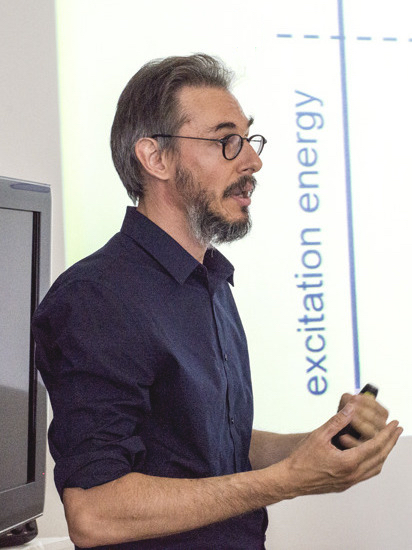Massimo Rontani

Since 2018, is head of the Modena branch of Istituto Nanoscienze – CNR-NANO, Italy, which employs over 40 permanent researchers.
Since 2021, is Research Director (Dirigente di Ricerca) at CNR-NANO.

I am interested in the understanding, modelling, and first-principles simulation of realistic low-dimensional systems and their spectroscopies, as laboratories to unravel many-body physics.
The topics of my research include:
Excitons and excitonic insulator
I have been fascinated by the possibility of the permanent Bose-Einstein condensation of excitons throughout my whole career (PRL 94, 186404 (2005); PRB 80, 075309 (2009)), starting from my undergraduate work with Lu Sham (APL 77, 3303 (2000)). This seemed to be quite an academic topic until recently, when new 2d materials with enhanced electron-hole attractions offered a new arena to test old, charming ideas. Since 2017, I revived the field as a senior author of a series of papers in which I predict with quantitative accuracy diverse materials to be excitonic insulators, by means of combining first-principles and model approaches (PRB 105, 195404 (2022); Nature Phys 18, 94 (2022); PNAS 118, e2010110118 (2021); Nature Nanotech 15, 367 (2020); PRL, 121, 127704 (2018); Nature Commun, 8, 1461 (2017)).
Main collaborations with the experimental groups of D. Cobden, S. Ilani, G. Steele, E. Minot, F. Sette, P. Abbamonte.
Collaborations with the theory groups of S. Corni, S. Sorella, M. Palummo.
Wigner crystallization in low-d systems
The Wigner crystal is a fascinating state of matter, made of strongly interacting electrons, which is notoriously difficult to realize in the quantum regime, due to the required ultra-low density and absence of disorder. Low-d systems provided a valuable path for its observation, as I demonstrated for quantum dots at relatively high electron density in a series of joint experimental-theoretical papers (Nat Phys 4, 467 (2008); PRL 104, 246802 (2010); PRB 85, 033307 (2012)). Here, the agreement between computed and measured inelastic light scattering spectra hinted at the formation of the roto-vibrational modes of a Wigner molecule. Following the observation of spin-orbit coupling in carbon nanotubes, I was the first to realize that the reported Coulomb blockade spectra were hiding signatures of ultra-strong electron correlation (PRB 80, 041404 (2009)). My prediction of Wigner crystallization in available tubes, based on extensive ED simulations (PRB 82, 035417 (2010); PRB 85, 121410 (2012); PRB 88, 125403 (2013)), were later confirmed in a joint theoretical-experimental work (Nat Phys 9, 576 (2013)).
Main collaboration with the experimental groups of V. Pellegrini, S. Ilani.
Few-body physics of quantum dots, molecules, cold Fermi atoms
Semiconductor quantum dots are wonderful systems to explore the physics of a few strongly interacting electrons, as the relevant energy scales may be tuned in the lab while electrons are poured one by one into the dot through Coulomb blockade. I developed from scratch a state-of the-art exact diagonalization (ED) code to accurately treat correlated few-body states (JCP 124, 124102 (2006)), which led to the successful collaboration with major experimental groups (PRB 69, 085327 (2004); PRL 95, 236801 (2005); PRL 95, 266806 (2005); Nano Lett 7, 2701 (2007); Nat Nano 9, 997 (2014)). I exported key ideas of quantum-dot and molecular physics (PRB 71, 233106 (2005); PRL 110, 018305 (2013)) into the realm of cold Fermi atoms, such as shell filling, Hund’s rule (PRL 102, 060401 (2009)), tunneling spectroscopy, which were influential to following developments. I proposed the first theoretical interpretation of a breakthrough experiment by S Jochim on the tunneling of a few 6Li atom out of a trap, unveiling the key role of atom-atom correlations as well as the nature of pairing in 1d (PRL 108, 115302 (2012); PRA 91, 043610 (2013)).
Main collaborations with the experimental groups of S. Tarucha, R. Wiesendanger, V. Pellegrini, L. Sorba, S. Jochim. Collaborations with the theory groups of S. Reimann, S. Corni, S. Sorella.
